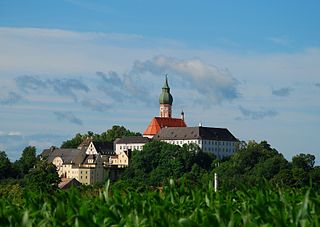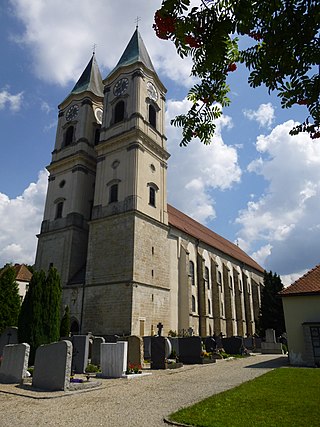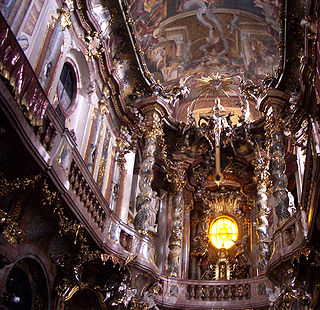
Andechs Abbey is a Benedictine priory in the municipality of Andechs, in the Landkreis of Starnberg, Upper Bavaria, Germany. A place of pilgrimage on a hill east of the Ammersee, the Abbey is famed for its flamboyant Baroque church and its brewery, Klosterbrauerei Andechs, the proceeds from which help fund the monks' mission of help. Composer Carl Orff is buried in the church.

Ettal Abbey is a Benedictine monastery in the village of Ettal close to Oberammergau and Garmisch-Partenkirchen in Bavaria, Germany. With a community of more than 50 monks, with another five at Wechselburg, the Abbey is one of the largest Benedictine houses and is a major attraction for visitors.

Tegernsee is a town in the Miesbach district of Bavaria, Germany. It is located on the shore of Lake Tegernsee, which is 747 m (2,451 ft) above sea level. A spa town, it is surrounded by an alpine landscape of Upper Bavaria, and has an economy mainly based on tourism.

Ottobeuren is a Benedictine abbey, located in Ottobeuren, near Memmingen in the Bavarian Allgäu, Germany.

Ilmmünster Abbey was a collegiate foundation (Kollegiatstift) of canons, formerly a Benedictine monastery, in Ilmmünster, Bavaria, Germany. The church continues in use as a parish church.

Wessobrunn Abbey was a Benedictine monastery near Weilheim in Bavaria, Germany.

Niederaltaich Abbey is a house of the Benedictine Order founded in 741, situated in the village of Niederalteich on the Danube in Bavaria.

Benediktbeuern Abbey is an institute of the Salesians of Don Bosco, originally a monastery of the Benedictine Order, in Benediktbeuern in Bavaria, near the Kochelsee, 64 km south-south-west of Munich. It is the oldest and one of the most beautiful monasteries in Upper Bavaria.

Altomünster Abbey was a monastery in the small Bavarian market town of Altomünster.

Weltenburg Abbey is a Benedictine monastery in Weltenburg near Kelheim on the Danube in Bavaria, Germany.

Weihenstephan Abbey was a Benedictine monastery in Weihenstephan, now part of the district of Freising, in Bavaria, Germany. Brauerei Weihenstephan, located at the monastery site since at least 1040, is said to be the world's oldest continuously operating brewery.

St. Boniface's Abbey is a Benedictine monastery in Maxvorstadt, Munich, Bavaria, Germany. It was founded in 1835 by King Ludwig I of Bavaria, as a part of his efforts to reanimate the country's spiritual life by the restoration of the monasteries destroyed during the secularisation of the early 19th century.
The Bavarian Congregation is a congregation of the Benedictine Confederation consisting of monasteries in Bavaria, Germany.

Mondsee Abbey was a Benedictine monastery in Mondsee in Upper Austria.

Břevnov Monastery is a Benedictine archabbey in the Břevnov district of Prague, Czech Republic. It was founded by Saint Adalbert, the second Bishop of Prague, in 993 AD with the support of Bohemian Duke Boleslaus II. The first Benedictine male monastery in Bohemia, it also has the oldest tradition of beer brewing in the Czech Republic. Brewing was interrupted several times in the history, but up to today, the Břevnov Monastery Brewery brew its beer here.

Egid Quirin Asam was a German plasterer, sculptor, architect, and painter. He was active during the Late Baroque and Rococo periods.

The Asam brothers were sculptors, painters, and architects, who worked mostly together and in southern Germany. They are among the most important representatives of the German late Baroque.

St. Ulrich's and St. Afra's Abbey, Augsburg is a former Benedictine abbey dedicated to Saint Ulrich and Saint Afra in the south of the old city in Augsburg, Bavaria.
The Ducal Bavarian Brewery of Tegernsee is a brewery in Tegernsee, Bavaria, Germany, located inside the north wing of former Tegernsee Abbey and owned by Maria Anna, Duchess in Bavaria, youngest daughter of Max, Duke in Bavaria.




















